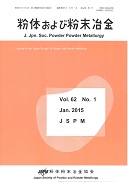巻号一覧

62 巻, 11 号
November
選択された号の論文の6件中1~6を表示しています
- |<
- <
- 1
- >
- >|
特集:イオン伝導材料
研究論文
-
Machiko ABE, Kota SUZUKI, Hiroaki MINAMISHIMA, Kyungsu KIM, Sou TAMINA ...2015 年 62 巻 11 号 p. 531-537
発行日: 2015/11/15
公開日: 2015/12/02
ジャーナル オープンアクセスControl over the fractions of layered rock salt and spinel-type phases in Li-(Mn,Co,Ni)-O electrodes was demonstrated using a pulsed laser deposition method. Li-(Mn,Co,Ni)-O epitaxial thin films were deposited on a SrTiO3 (110) substrate and laser energy density (or fluence) was varied to obtain phase fraction control. X-ray diffraction measurements confirmed that the thin films had layered rock salt and spinel-type phases with (1-18) and (110) orientations, respectively. Systematic changes of the phase fraction with fluence variation were clearly confirmed. Relatively low fluence (<900 mJ cm−2) favors the formation of a layered phase while the spinel phase is obtained with higher fluence values (>1000 mJ cm−2). The lithium content in the film determines the fraction of each phase, and higher fluence values lead to lower lithium contents in the spinel phase. These two-phase films show lithium (de)intercalation activities with blended electrode characteristics in their cyclic voltammograms. These films could serve as model electrodes allowing analysis of the reactions of blended Li(Mn,Co,Ni)O2 systems under battery operation conditions.抄録全体を表示PDF形式でダウンロード (680K) -
梶山 亮尚, 與田 晃, 正木 竜太, 脇山 剛, 松本 和順, 稲田 太郎, 横田 博, 菅野 了次2015 年 62 巻 11 号 p. 538-542
発行日: 2015/11/15
公開日: 2015/12/02
ジャーナル オープンアクセスThe interfacial reactions that contributed to the gas formation between carbon conductive agents and the electrolyte at the positive electrode in high-voltage batteries, potentials over 4.5 V, have been investigated. The amount of gas generated was quantified for various conductive agents: acetylene black (AB), furnace black (FB), specially customized AB, and graphite (GR). The experiments revealed that in the high-voltage system, the specific gas evolution was induced by both the cathode active material and the conductive agent. The high-voltage properties of the carbon conductive agents, such as the anion intercalation and self-discharging properties, were evaluated for each carbon electrode. The results implied the existence of a local battery composed of the conductive agent and LNi0.5Mn1.5O4. This redox couple appears to play a key role in the gas evolution, which was sensitive to crystallinity, surface area and metallic impurities of conductive agents.抄録全体を表示PDF形式でダウンロード (849K) -
趙 国偉, MUHAMMAD Iqbal, 鈴木 耕太, 平山 雅章, 菅野 了次2015 年 62 巻 11 号 p. 543-547
発行日: 2015/11/15
公開日: 2015/12/02
ジャーナル オープンアクセスNew lithium ion conductors of M-doped LiScO2 (M = Zr, Nb, and Ta) were synthesized by a solid-state reaction method. Peak shifts of the X-ray diffraction patterns revealed the formation of solid solutions with aliovalent cation doping. In addition, increase in the ionic conductivity by the M doping is indicated. The highest total conductivity of 7.94 × 10−6 S cm−1 at 623 K with an activation energy of 88 ± 5 kJ mol−1 was observed for the Zr4+ doped sample in the systems. The Zr4+ doped system showed the largest solid solution limit in Li1−xSc1−xZrxO2 (x ≈ 0.1) and continuous increase of the conductivity with increasing x. Structural analysis by Rietveld refinement indicated that the lattice expansion and lithium-ion vacancy formation by the Zr doping in the structure, which could contribute to the increase in the ionic conductivity.抄録全体を表示PDF形式でダウンロード (483K) -
Wen Jing LI, 平山 雅章, 鈴木 耕太, 菅野 了次2015 年 62 巻 11 号 p. 548-552
発行日: 2015/11/15
公開日: 2015/12/02
ジャーナル オープンアクセスTiS2/Li10GeP2S12 composite electrodes were fabricated using a mill pot rotator, and their electrochemical properties were investigated with all solid-state batteries of TiS2/Li10GeP2S12/In-Li. The batteries compressed under 19 MPa showed poor cycle stability and low rate capability due to deterioration of physical contact between the TiS2 electrode and the Li10GeP2S12 solid-electrolyte. The battery performance was much improved by applying a pressure of 230 MPa throughout the electrochemical cycling. The battery delivered the reversible capacity of over 160 mAh g−1 with high retention under 1 C operation condition.抄録全体を表示PDF形式でダウンロード (995K)
本会記事
-
2015 年 62 巻 11 号 p. Pref11_1-
発行日: 2015/10/15
公開日: 2015/12/02
ジャーナル オープンアクセスPDF形式でダウンロード (178K) -
2015 年 62 巻 11 号 p. Mtg11_2-Mtg11_6
発行日: 2015/10/15
公開日: 2015/12/02
ジャーナル オープンアクセスPDF形式でダウンロード (380K)
- |<
- <
- 1
- >
- >|